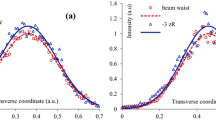Abstract
Sharply focused pulses are required to modify transparent materials by femtosecond laser pulses. To model the modification process, it is necessary to compute the distribution of the electric field of the laser pulse at distances of the order of hundreds of microns from the focus. The frequently used paraxial approximation in the case of a sharp focus is not applicable. It is necessary to calculate a specific optical system. In the case when a parabolic mirror is used as a focusing element, the desired field distribution can be obtained using the Stratton–Chu integral (SCI). In this paper the generalization of the SCI to the case of a finite-time (femtosecond) pulse and a simplification of the SCI for the case of a large mirror located far from the focus are presented. This is typical for a wide range of practical problems. In addition, specific formulas of the SCI for frequently used polarizations of laser pulses are given. The main achievement of this paper is the development of extremely effective numerical methods of computing the SCI, which is the integral of a rapidly oscillating function. As an example, the calculation of the field of a focused laser pulse with a cylindrical intensity distribution along the radius (top-hat pulse) is given.




Similar content being viewed by others
REFERENCES
D. Tan, K. N. Sharafudeen, Y. Yue, and J. Qiu, “Femtosecond laser induced phenomena in transparent solid materials: Fundamentals and applications,” Progr. Mater. Sci. 76, 154–228 (2016). https://doi.org/10.1016/j.pmatsci.2015.09.002
H. Misawa and S. Juodkazis, 3D Laser Microfabrication: Principles and Applications (Wiley, Weinheim, 2006).
R. R. Gattass and E. Mazur, “Femtosecond laser micromachining in transparent materials,” Nature Photon. 2, 219–225 (2008). https://doi.org/10.1038/nphoton.2008.47
S. M. Yalisove, K. Sugioka, and C. P. Grigoropoulos, “Advances and opportunities of ultrafast laser synthesis and processing,” MRS Bull. 41, 955–959 (2016). https://doi.org/10.1557/mrs.2016.273
N. Linz, S. Freidank, X.-X. Liang, and A. Vogel, “Wavelength dependence of femtosecond laser-induced breakdown in water and implications for laser surgery,” Phys. Rev. B 94, 024113 (2016). https://doi.org/10.1103/PhysRevB.94.024113
A. Couairon, L. Sudrie, M. Franco, B. Prade, and A. Mysyrowicz, “Filamentation and damage in fused silica induced by tightly focused femtosecond laser pulses,” Phys. Rev. B 71, 125435 (2005). https://doi.org/10.1103/PhysRevB.71.125435
I. M. Burakov, N. M. Bulgakova, R. Stoian, A. Mermillod-Blondin, E. Audouard, A. Rosenfeld, A. Husakou, and I. V. Hertel, “Spatial distribution of refractive index variation induced in bulk fused silica by single ultrashort and short laser pulses,” J. Appl. Phys. 101, 043506 (2007). https://doi.org/10.1063/1.2436925
A. V. Dostovalov, A. A. Wolf, V. K. Mezentsev, A. G. Okhrimchuk, and S. A. Babin, “Quantitative characterization of energy absorption in femtosecond laser micro-modification of fused silica,” Opt. Express 23, 32541–32547 (2015). https://doi.org/10.1364/oe.23.032541
K. I. Popov, C. McElcheran, K. Briggs, S. Mack, and L. Ramunno, “Morphology of femtosecond laser modification of bulk dielectrics,” Opt. Express 19, 271–282 (2011). https://doi.org/10.1364/OE.19.000271
C. L. Arnold, A. Heisterkamp, W. Ertmer, and H. Lubatschowski, “Computational model for nonlinear plasma formation in high NA micromachining of transparent materials and biological cells,” Opt. Express 15, 10303−10317 (2007). https://doi.org/10.1364/OE.15.010303
V. P. Zhukov and M. P. Fedoruk, “Numerically implemented impact of a femtosecond laser pulse on glass in the approximation of nonlinear Maxwell equations,” Math. Models Comput. Simul. 12, 77–89 (2020). https://doi.org/10.1134/S207004822001010X
V. P. Zhukov, A. M. Rubenchik, M. P. Fedoruk, and N. M. Bulgakova, “Interaction of doughnut-shaped laser pulses with glasses,” J. Opt. Soc. Am. B 34, 463–471 (2017). https://doi.org/10.1364/JOSAB.34.000463
V. P. Zhukov, N. M. Bulgakova, and M. P. Fedoruk, “Nonlinear Maxwell’s and Schrödinger equations for describing the volumetric interaction of femtosecond laser pulses with transparent solid dielectrics: Effect of the boundary conditions,” J. Opt. Technol. 84, 439–446 (2017). https://doi.org/10.1364/JOT.84.000439
A. Becker, N. Aközbek, K. Vijayalakshmi, E. Oral, C. M. Bowden, and S. L. Chin, “Intensity clamping and re-focusing of intense femtosecond laser pulses in nitrogen molecular gas,” Appl. Phys. B 73, 287–290 (2001). https://doi.org/10.1007/s003400100637
Q. Sun, F. Liang, R. Vallée, and S. L. Chin, “Nanograting formation on the surface of silica glass by scanning focused femtosecond laser pulses,” Opt. Lett. 33, 2713–2715 (2008). https://doi.org/10.1364/OL.33.002713
J. A. Stratton and L. J. Chu, “Diffraction theory of electromagnetic waves,” Phys. Rev. 56, 99–107 (1939). https://doi.org/10.1103/PhysRev.56.99
K. I. Popov, V. Yu. Bychenkov, W. Rozmus, and R. D. Sydora, “Electron vacuum acceleration by tightly focused laser pulse,” Phys. Plasmas 15, 013108 (2008). https://doi.org/10.1063/1.2830651
ACKNOWLEDGMENTS
The authors thank N.M. Bulgakova for her helpful discussions.
Author information
Authors and Affiliations
Corresponding author
Ethics declarations
The authors declare that they have no conflicts of interest.
Rights and permissions
About this article
Cite this article
Zhukov, V.P., Fedoruk, M.P. Boundary Conditions in Modeling the Modification of Materials by Laser Pulses. Math Models Comput Simul 15, 905–919 (2023). https://doi.org/10.1134/S2070048223050149
Received:
Revised:
Accepted:
Published:
Issue Date:
DOI: https://doi.org/10.1134/S2070048223050149




